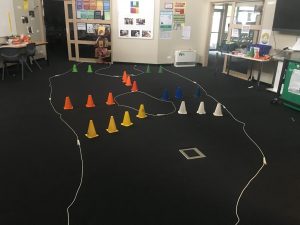The focus of this activity is to encourage students to use trial and error and persistence to solve the problem. Often problems have solutions – this problem has no solution. Students need to understand that sometimes “no solution” is a solution. Learning from this – how can students modify the layout of the bridges to make a route over 7 bridges possible?
Purpose
- Identify the qualities of a good mathematician
- Demonstrate the qualities of a good mathematician
- Use trial and error to investigate the problem
- Share ideas and approaches with other students
- Use a grid to create a map of Konigsberg
- Identify key features of a map, including labels
- Include key features on grid maps of familiar locations
- Apply knowledge of the Konigsberg Bridge problem to solve similar problems
- Explain and record thinking using a systematic approach
Curriculum Connections (Location and Transformations)
- Create and interpret simple grid maps to show position and pathways (VCMMG143)
- Use simple scales, legends and directions to interpret information contained in basic maps (VCMMG172)
At the end of this lesson students should be able to answer the following questions
- What do you notice about this problem?
- How many locations are there? How many bridges?
- Do you think a route that travels on all 7 bridges is possible?
- What method will you use to track your progress?
- Did you take a systematic approach?
- Can you represent the problem as a map?
- What features of the map should be included?
- Can you redraw the map so a route is possible?
- How can this information be used to solve similar pathway problems?
For more information, please download the attached lesson plan.
Recommended Posts



